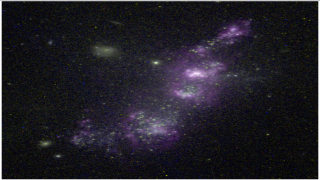Bibcode
Sparks, William B.; Deustua, Susana; Rodríguez-Zaurín, J.; Capetti, Alessandro; Chiaberge, Marco; Baldi, Ranieri D.
Bibliographical reference
The Astrophysical Journal, Volume 762, Issue 1, article id. 30, 18 pp. (2013).
Advertised on:
1
2013
Journal
Citations
14
Refereed citations
11
Description
We study the spectral energy distributions, SEDs (from FUV to MIR
bands), of the first sizeable sample of 34 low-luminosity radio galaxies
at high redshifts, selected in the COSMOS field. To model the SEDs, we
use two different template-fitting techniques: (1) the Hyperz code that
only considers single stellar templates and (2) our own developed
technique 2SPD that also includes the contribution from a young stellar
population and dust emission. The resulting photometric redshifts range
from z ~ 0.7 to 3 and are in substantial agreement with measurements
from earlier work, but significantly more accurate. The SED of most
objects is consistent with a dominant contribution from an old stellar
population with an age ~1-3 × 109 years. The inferred
total stellar mass range is ~1010-1012 M
☉. Dust emission is needed to account for the 24 μm
emission in 15 objects. Estimates of the dust luminosity yield values in
the range L dust ~ 1043.5-1045.5 erg
s–1. The global dust temperature, crudely estimated for
the sources with an MIR excess, is ~300-850 K. A UV excess is often
observed with a luminosity in the range ~1042-1044
erg s–1 at 2000 Å rest frame. Our results show
that the hosts of these high-z low-luminosity radio sources are old
massive galaxies, similar to the local FR Is. However, the UV and MIR
excesses indicate the possible significant contribution from star
formation and/or nuclear activity in such bands, not seen in low-z FR
Is. Our sources display a wide variety of properties: from possible
quasars at the highest luminosities to low-luminosity old galaxies.
Related projects

Starbursts in Galaxies GEFE
Starsbursts play a key role in the cosmic evolution of galaxies, and thus in the star formation (SF) history of the universe, the production of metals, and the feedback coupling galaxies with the cosmic web. Extreme SF conditions prevail early on during the formation of the first stars and galaxies, therefore, the starburst phenomenon constitutes a
Casiana
Muñoz Tuñón